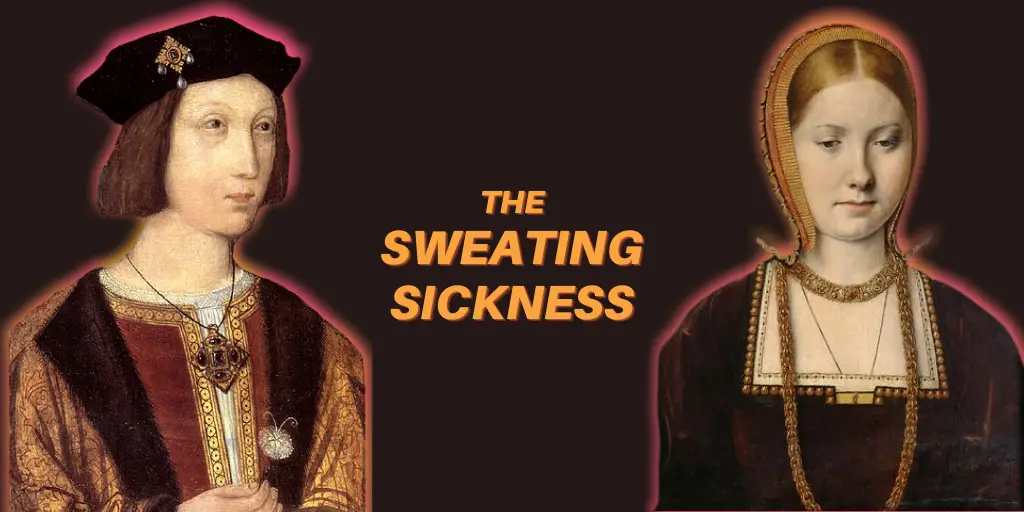The Sweating Sickness
[et_pb_section fb_built=”1″ _builder_version=”4.0.9″][et_pb_row _builder_version=”4.0.9″][et_pb_column type=”4_4″ _builder_version=”4.0.9″][et_pb_text _builder_version=”4.7.7″ text_font_size=”15px”]
You might have noticed that there is a bit of a “bug” floating around at the moment.
Where do these viruses come from? COVID must have been made in a Wuhan laboratory…right?
History tells us that viruses do “appear” from nowhere regularly.
Today, I’m proud to give you…
The Sweating Sickness.
It was the disease that changed the face of English history forever. (Read to the end.)
[/et_pb_text][/et_pb_column][/et_pb_row][et_pb_row _builder_version=”4.0.9″][et_pb_column type=”4_4″ _builder_version=”4.0.9″][et_pb_text _builder_version=”4.7.7″ header_2_text_color=”#7e0f82″]
What were the Symptoms?
[/et_pb_text][/et_pb_column][/et_pb_row][et_pb_row _builder_version=”4.0.9″][et_pb_column type=”4_4″ _builder_version=”4.0.9″][et_pb_text _builder_version=”4.7.7″ text_font_size=”15px”]
The first outbreak occurred in England in 1485. For most who contracted it, it was swift, devastating and merciless.
John Caius was a doctor in Shrewsbury and recorded in detail in the symptoms and progression of the sweating sickness:
It started with an overwhelming sense of apprehension or impending doom.
Then the cold shivers started, sometimes violent enough to crack ribs.
Then came the dizziness, headaches, pain in the limbs and overwhelming exhaustion.
This was described as the “cold” stage, and it lasted around three hours.
Then came the sweats. (What gave the illness it’s name.)
The skin was hot to the touch, the heart rate rose to dangerous levels, and a great thirst accompanied it.
Chest pains and palpitations swiftly followed.
Then came collapse, and the overwhelming urge to sleep.
Death usually occurred within 24 hours of the first symptoms.
Fun or what?
The phrase that was often used in Tudor England was that people were merry at dinner and then dead by supper.
The French ambassador, Cardinal du Bellay put it rather simply, “This disease… is the easiest in the world to die of. You have a slight pain in the head and at the heart; all at once you begin to sweat. There is no need for a physician… you are taken off without languishing.”
[/et_pb_text][/et_pb_column][/et_pb_row][et_pb_row _builder_version=”4.0.9″][et_pb_column type=”4_4″ _builder_version=”4.0.9″][et_pb_text _builder_version=”4.0.9″ header_2_text_color=”#7e0f82″]
When was the first outbreak?
[/et_pb_text][/et_pb_column][/et_pb_row][et_pb_row _builder_version=”4.0.9″][et_pb_column type=”4_4″ _builder_version=”4.0.9″][et_pb_text _builder_version=”4.7.7″ text_font_size=”15px”]
This first outbreak of the sweating sickness occurred just after the Battle of Bosworth and the defeat of Richard III.
The Yorkists considered it an omen against the new Tudor rulers.
That first outbreak took out thousands of people in England. If you consider the population of the entire country was less than 2 million at the time, these weren’t insignificant numbers.
In a massive outbreak in 1507 over half the population of inflicted villages died. That’s a pretty contagious disease.
The last major outbreak of the sweating sickness occurred in England in 1551.
Then just as quickly as it arrived, it was gone.
It disappeared never to return.
[/et_pb_text][/et_pb_column][/et_pb_row][et_pb_row _builder_version=”4.0.9″][et_pb_column type=”4_4″ _builder_version=”4.0.9″][et_pb_text _builder_version=”4.0.9″ header_2_text_color=”#7e0f82″]
What was the sweating sickness?
[/et_pb_text][/et_pb_column][/et_pb_row][et_pb_row _builder_version=”4.0.9″][et_pb_column type=”4_4″ _builder_version=”4.0.9″][et_pb_text _builder_version=”4.7.7″ text_font_size=”15px”]
To this day, we don’t know.
Some scientists have suggested that it was some form of malaria.
Others have suggested some form of hantavirus that generally infect rodents. Scientists point out the similar nature of hantavirus pulmonary syndrome that can infect humans.
In 2004 Anthrax poisoning was put forward as a possibility. Anthrax spores could have been present in raw wool or animal carcasses. However, if that were the case, why did the sweating sickness die out?
It has been suggested that the mercenary troops that Henry Tudor landed with at Milford Haven, brought it with them. The first outbreak in London occurred in early September 1485. Henry VII arrived in London after his victory at Bosworth in late August.
There seems to be an obvious link there. Yet, if this was the source, why are there no recorded incidents of the sweating sickness on continental Europe before the Battle of Bosworth? If it was some form of hantavirus, then it could be that rats came on board the ships with the troops?
The answer to this question will almost certainly never be answered with certainty.
Almost as great as the mystery as to what it was, was it why the Sweating Sickness disappeared!
Again, there is no logical answer.
But there is no doubt that the sweat changed England forever.
[/et_pb_text][/et_pb_column][/et_pb_row][et_pb_row _builder_version=”4.0.9″][et_pb_column type=”4_4″ _builder_version=”4.0.9″][et_pb_text _builder_version=”4.0.9″ header_2_text_color=”#7e0f82″]
Where any famous people struck down with the sweating sickness?
[/et_pb_text][/et_pb_column][/et_pb_row][et_pb_row _builder_version=”4.0.9″][et_pb_column type=”4_4″ _builder_version=”4.0.9″][et_pb_text _builder_version=”4.7.7″ text_font_size=”15px” hover_enabled=”0″ sticky_enabled=”0″]
The sweat was indiscriminate. It killed rich and poor alike. It claimed the life of Thomas Cromwell’s wife and children; it claimed the life of the son of the Duke of Suffolk. Money could not save you from its merciless kiss.
Yet, others survived.
Cardinal Wolsey, Henry VIII’s first chief minister, survived two bouts of the sweating sickness.
Anne Boleyn also caught it while she was still Henry VIII’s mistress, as did her father, Thomas. Both survived.
However, Anne’s sister’s husband, William Carey, died from it.
In March 1502 it struck its two most important victims.
Catherine of Aragon and her new husband, Arthur Tudor, Prince of Wales.
Arthur was Henry VII and Elizabeth of York’s eldest child. He was the child that symbolised the unity of the Houses of Lancaster and York. As such he was named after the legendary English King Arthur.
Even being heir to the throne of England couldn’t save Arthur.
He died on the 2nd April 1502 in Ludlow Castle.
This meant that Arthur’s younger brother, Henry Duke of York now became heir to the throne.
After the death of Henry VII, the 17-year-old Henry VIII became King of England. The first thing he did was marry his brother’s widow Catherine, who survived the sweating sickness.
[/et_pb_text][/et_pb_column][/et_pb_row][et_pb_row _builder_version=”4.0.9″][et_pb_column type=”4_4″ _builder_version=”4.0.9″][et_pb_text _builder_version=”4.0.9″ header_2_text_color=”#7e0f82″]
What would have been different if the Sweating Sickness had never occurred?
[/et_pb_text][/et_pb_column][/et_pb_row][et_pb_row _builder_version=”4.0.9″][et_pb_column type=”4_4″ _builder_version=”4.0.9″][et_pb_text _builder_version=”4.7.7″ text_font_size=”15px”]
The sweating sickness no longer exists in England or anywhere in the world. However, as we have seen recently, new illness occurs regularly. Is it possible that COVID might disappear like the sweating sickness? It is a possibility, but it isn’t likely as the population of the world is far greater than it was back in Tudor times.
These strange new illnesses have the potential to change the world forever.
Imagine if the sweating sickness had never arrived in England.
We would never have had a Henry VIII and, as such, never had an Elizabeth 1. (Imagine never having me as King of England.)
And as such we wouldn’t have had the break from Rome and the dissolution of the monasteries.
England would be a very different place, and all because of a mystery illness called The Sweating Sickness.
[/et_pb_text][/et_pb_column][/et_pb_row][/et_pb_section]






